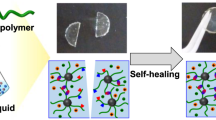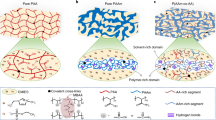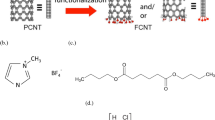Abstract
(2 × 4)-Type tetra-PEG ion gels were prepared through a copper-free azide–alkyne cycloaddition reaction between azide-functionalized tetra-branched poly(ethylene glycol) and electron-deficient alkyne-functionalized tetra(ethylene glycol) in 1-ethyl-3-methylimidazolium bis(trifluoromethylsulfonyl)imide. The thermal, mechanical, and electrochemical properties of the ion gels were characterized. The tensile tests showed that the reaction efficiency of the cross-linking was over 90%. The prepared ion gels exhibited high mechanical toughness and stretchability characteristic of tetra-PEG gels. The electrochemical window of the ion gels was the same as that of the ionic liquid inside the gel. The ionic conductivities of the ion gels with 30 and 50 wt% polymer concentrations were 8.9 and 1.4 × 10−4 S cm−1, respectively (25 °C, anhydrous conditions).
This is a preview of subscription content, access via your institution
Access options
Subscribe to this journal
Receive 12 print issues and online access
$259.00 per year
only $21.58 per issue
Buy this article
- Purchase on Springer Link
- Instant access to full article PDF
Prices may be subject to local taxes which are calculated during checkout






Similar content being viewed by others
References
Arya A, Sharma AL. Polymer electrolytes for lithium ion batteries: a critical study. Ionics. 2017;23:497–540.
Mindemark J, Lacey MJ, Bowden T, Brandell D. Beyond PEO-alternative host materials for Li+-conducting solid polymer electrolytes. Prog Polym Sci. 2018;81:114–43.
Cheng XL, Pan J, Zhao Y, Liao M, Peng HS. Gel polymer electrolytes for electrochemical energy storage. Adv Energy Mater. 2018;8:1702184.
Kusoglu A, Weber AZ. New insights into perfluorinated sulfonic-acid ionomers. Chem Rev. 2017;117:987–1104.
Shin DW, Guiver MD, Lee YM. Hydrocarbon-based polymer electrolyte membranes: importance of morphology on ion transport and membrane stability. Chem Rev. 2017;117:4759–805.
Li J, Qiao JL, Lian K. Hydroxide ion conducting polymer electrolytes and their applications in solid supercapacitors: a review. Energy Storage Mater. 2020;24:6–21.
Wang ZF, Zhu MS, Pei ZX, Xue Q, Li HF, Huang Y, Zhi CY. Polymers for supercapacitors: boosting the development of the flexible and wearable energy storage. Mater Sci Eng R Rep. 2020;139:100520.
Hou WJ, Xiao YM, Han GY, Lin JY. The applications of polymers in solar cells: a review. Polymers. 2019;11:143.
Iftikhar H, Sonai GG, Hashmi SG, Nogueira AF, Lund PD. Progress on electrolytes development in dye-sensitized solar cells. Materials. 2019;12:1998.
Alesanco Y, Vinuales A, Rodriguez J, Tena-Zaera R. All-in-one gel-based electrochromic devices: strengths and recent developments. Materials. 2018;11:414.
Susan MA, Kaneko T, Noda A, Watanabe M. Ion gels prepared by in situ radical polymerization of vinyl monomers in an ionic liquid and their characterization as polymer electrolytes. J Am Chem Soc. 2005;127:4976–83.
Le Bideau J, Viau L, Vioux A. Ionogels, ionic liquid based hybrid materials. Chem Soc Rev. 2011;40:907–25.
Marr PC, Marr AC. Ionic liquid gel materials: applications in green and sustainable chemistry. Green Chem. 2016;18:105–28.
Rana HH, Park JH, Gund GS, Park HS. Highly conducting, extremely durable, phosphorylated cellulose-based ionogels for renewable flexible supercapacitors. Energy Storage Mater. 2020;25:70–5.
Watanabe M, Thomas ML, Zhang SG, Ueno K, Yasuda T, Dokko K. Application of ionic liquids to energy storage and conversion materials and devices. Chem Rev. 2017;117:7190–239.
Yang QW, Zhang ZQ, Sun XG, Hu YS, Xing HB, Dai S. Ionic liquids and derived materials for lithium and sodium batteries. Chem Soc Rev. 2018;47:2020–64.
Liu H, Yu HJ. Ionic liquids for electrochemical energy storage devices applications. J Mater Sci Technol. 2019;35:674–86.
Okumura Y, Ito K. The polyrotaxane gel: a topological gel by figure-of-eight cross-links. Adv Mater. 2001;13:485–7.
Ito K. Slide-ring materials using cyclodextrin. Chem Pharm Bull. 2017;65:326–9.
Haraguchi K, Takehisa T. Nanocomposite hydrogels: a unique organic-inorganic network structure with extraordinary mechanical, optical, and swelling/de-swelling properties. Adv Mater. 2002;14:1120–4.
Haraguchi K. Soft nanohybrid materials consisting of polymer-clay networks. Adv Polym Sci. 2015;267:187–248.
Gong JP, Katsuyama Y, Kurokawa T, Osada Y. Double-network hydrogels with extremely high mechanical strength. Adv Mater. 2003;15:1155–8.
Gong JP. Why are double network hydrogels so tough? Soft Matter. 2010;6:2583–90.
Sakai T, Matsunaga T, Yamamoto Y, Ito C, Yoshida R, Suzuki S, Sasaki N, Shibayama M, Chung UI. Design and fabrication of a high-strength hydrogel with ideally homogeneous network structure from tetrahedron-like macromonomers. Macromolecules. 2008;41:5379–84.
Shibayama M, Li X, Sakai T. Precision polymer network science with tetra-PEG gels a decade history and future. Colloid Polym Sci. 2019;297:1–12.
Watanabe T, Takahashi R, Ono T. Preparation of tough, thermally stable, and water-resistant double-network ion gels consisting of silica nanoparticles/poly(ionic liquid)s through photopolymerisation of an ionic monomer and subsequent solvent removal. Soft Matter. 2020;16:1572–81.
Fujii K, Asai H, Ueki T, Sakai T, Imaizumi S, Chung UI, Watanabe M, Shibayama M. High-performance ion gel with tetra-PEG network. Soft Matter. 2012;8:1756–9.
Hashimoto K, Fujii K, Nishi K, Sakai T, Shibayama M. Nearly ideal polymer network ion gel prepared in pH-buffering ionic liquid. Macromolecules. 2016;49:344–52.
Ishii S, Kokubo H, Hashimoto K, Imaizumi S, Watanabe M. Tetra-PEG network containing ionic liquid synthesized via Michael addition reaction and its application to polymer actuator. Macromolecules. 2017;50:2906–15.
Yoshitake M, Kamiyama Y, Nishi K, Yoshimoto N, Morita M, Sakai T, Fujii K. Defect-free network formation and swelling behavior in ionic liquid-based electrolytes of tetra-arm polymers synthesized using a Michael addition reaction. PCCP. 2017;19:29984–90.
Yoshitake M, Han J, Sakai T, Morita M, Fujii K. TetraPEG network formation via a Michael addition reaction in an ionic liquid: Application to polymer gel electrolyte for electric double-layer capacitors. Chem Lett. 2019;48:704–7.
Qin AJ, Tang L, Lam JWY, Jim CKW, Yu Y, Zhao H, Sun JZ, Tang BZ. Metal-free click polymerization: Synthesis and photonic properties of poly(aroyltriazole)s. Adv Funct Mater. 2009;19:1891–900.
Katritzky AR, Sakhuja R, Huang LC, Gyanda R, Wang L, Jackson DC, Ciaramitaro DA, Bedford CD, Duran RS. Effect of filler loading on the mechanical properties of cross linked 1,2,3-triazole polymers. J Appl Polym Sci. 2010;118:121–7.
Gorman IE, Willer RL, Kemp LK, Storey RF. Development of a triazole-cure resin system for composites: Evaluation of alkyne curatives. Polymer. 2012;53:2548–58.
Ikeda T. Copper-free synthesis of glycidyl triazolyl polymers. Macromol Chem Phys. 2018;219:1800147.
Tsuji Y, Li X, Shibayama M. Evaluation of mesh size in model polymer networks consisting of tetra-arm and linear poly(ethylene glycol)s. Gels. 2018;4:50.
Vrandecic NS, Erceg M, Jakic M, Klaric I. Kinetic analysis of thermal degradation of poly(ethylene glycol) and poly(ethylene oxide)s of different molecular weight. Thermochim Acta. 2010;498:71–80.
Vyas S, Dreyer C, Slingsby J, Bicknase D, Porter JM, Maupin CM. Electronic structure and spectroscopic analysis of 1-ethyl-3-methylimidazolium bis(trifluoromethylsulfonyl)imide ion pair. J Phys Chem A. 2014;118:6873–82.
Galinski M, Lewandowski A, Stepniak I. Ionic liquids as electrolytes. Electrochim Acta. 2006;51:5567–80.
Zardalidis G, Mars J, Allgaier J, Mezger M, Richter D, Floudas G. Influence of chain topology on polymer crystallization: poly(ethylene oxide) (PEO) rings vs. linear chains. Soft Matter. 2016;12:8124–34.
Kusuma VA, Macala MK, Baker JS, Hopkinson D. Cross-linked poly(ethylene oxide) ion gels containing functionalized imidazolium ionic liquids as carbon dioxide separation membranes. Ind Eng Chem Res. 2018;57:11658–67.
Shioiri R, Kokubo H, Horii T, Kobayashi Y, Hashimoto K, Ueno K, Watanabe M. Polymer electrolytes based on a homogeneous poly(ethylene glycol) network and their application to polymer actuators. Electrochim Acta. 2019;298:866–73.
Flory PJ. Molecular theory of rubber elasticity. Polym J. 1985;17:1–12.
Akagi Y, Katashima T, Katsumoto Y, Fujii K, Matsunaga T, Chung UI, Shibayama M, Sakai T. Examination of the theories of rubber elasticity using an ideal polymer network. Macromolecules. 2011;44:5817–21.
Barsoukov E, Macdonald JR. Impedance spectroscopy theory, experiment, and applications. 2nd ed. Hoboken: Wiley; 2005.
Mudraboyina BP, Obadia MM, Allaoua I, Sood R, Serghei A, Drockenmuller E. 1,2,3-Triazolium-based poly(ionic liquid)s with enhanced ion conducting properties obtained through a click chemistry polyaddition strategy. Chem Mater. 2014;26:1720–6.
Ikeda T, Moriyama S, Kim J. Imidazolium-based poly(ionic liquid)s with poly(ethylene oxide) main chains: effects of spacer and tail structures on ionic conductivity. J Polym Sci, Part A: Polym Chem. 2016;54:2896–906.
Acknowledgements
The author thanks Dr Junko Aimi for assistance with tensile tester operation. This work was financially supported by Grants-in-Aid for Scientific Research C, 18K04762 (JSPS) and M-Cube project (NIMS).
Author information
Authors and Affiliations
Corresponding author
Ethics declarations
Conflict of interest
The author declares that he has no conflict of interest.
Additional information
Publisher’s note Springer Nature remains neutral with regard to jurisdictional claims in published maps and institutional affiliations.
Rights and permissions
About this article
Cite this article
Ikeda, T. Preparation of (2 × 4)-type tetra-PEG ion gels through Cu-free azide–alkyne cycloaddition. Polym J 52, 1129–1135 (2020). https://doi.org/10.1038/s41428-020-0363-4
Received:
Revised:
Accepted:
Published:
Issue Date:
DOI: https://doi.org/10.1038/s41428-020-0363-4



